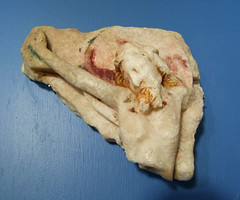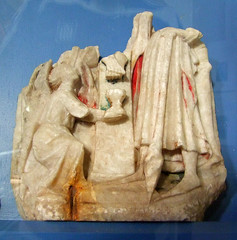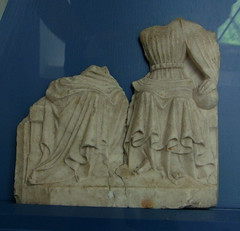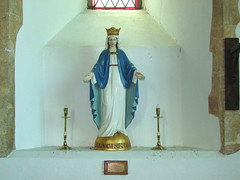| |
|
St Mary,
East Rudham
 |
|
I'd
been cycling quiet lanes for hours, so it was
with something of a shock that I was shot out
onto the busy King's Lynn to Fakenham road which
forms the main street through the village of East
Rudham. Unlike many paired village names in west
Norfolk, East and West Rudham merge into each
other, their churches barely half a mile apart.
St Peter at West Rudham is small, secretive and
redundant, all of an early 14th Century piece,
but East Rudham's St Mary is quite different, big
and triumphant beside the busy road. The clean,
crisp, Perpendicular lines of the church are a
witness to its complete rebuilding after the
tower collapsed into the nave in 1873, although
Pevsner got quite excited about the way that some
of the materials from the original church were
reused. It is likely that the plan is exactly
as-was, with the transepts a pleasing feature
unusual in this part of Norfolk. The south
doorway was retained, and some old bosses were
reset in the new porch. But as Pevsner also
hints, the somewhat dull and anonymous tower is a
disappointment at this time of high triumphalism
in the Church of England.
|
It is an
ill wind and all that, because during the rebuilding an
alcove opened up on the north side of the chancel was
found to contain fragments of a 15th century alabaster
reredos, as well as other fragments of images, which are
now on display in the north aisle. The most haunting of
these are probably the fragments of the Crucifixion,
Christ's head dropping in heavy-eyed agony while a
crouching angel at the foot of the cross collects drops
of his blood in a chalice.
  
Sam
Mortlock thought the interior rather wide, open and
bare, which isn't unfair, but the church has the
blessing of clear glass throughout, and on this summer
day it was full of light. The little spots of High Church
colour dotted about, especially in the south transept,
are lovely. Even so, it would take a big congregation not
to rattle around in here.
| The
chancel is similarly wide and open, filled with
light from the five-light east window. On the
south side beside the piscina, where you'd expect
the sedilia to be, there is a low blocked archway
which Pevsner thought had been the entrance to a
chapel. Even if the chancel has been raised, it
seems much too low to have been the entrance to
anything, although I suppose it might have been
reset during the rebuilding, in which case it
might come from anywhere I suppose. The font is
a survival from the earlier church, but only just
so, because it is dated 1852 at the bottom. A
memorial to Edward Manby dates from the same
year, and tells us that he practised with
much zeal and success the arts of medicine and
surgery in this parish more than 44 years.
Behind the font, a brass plaque of 1897
celebrates the 60th Year of the Reign of Her
Most Gracious Majesty Queen Victoria, in
commemoration of which event the Parish Clock
was placed in the tower of this church.
|
|
 |
|
|
|
